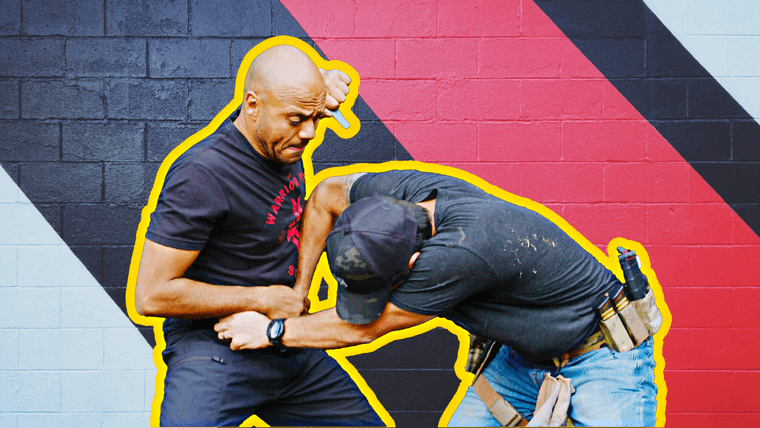How to Secure Your Gun With a Knife
Posted by Warrior Poet Society on Oct 25th 2022
Many violent encounters are up close and personal and can often threaten how well you're able to control your defensive tools. No matter how quick a pistol draw you have, being caught off guard by an attacker changes the game from defending yourself and loved ones to defending your firearm from being used against you and them. It's important to know how to defend your primary weapon with your secondary—such as a knife. Amir Khillah is a killer in this regard.
I spoke with Amir Khillah, expert (with black belts) in Tae Kwon Do, Hapkido, Jiu Jitsu, and Tang Soo Do and how to apply these in law enforcement and civilian scenarios—specifically to strengthen defensive options and decision making to avoid the use of lethal force. He's featured on the WPS Network as well.
Recently we worked through some scenarios where he demonstrated how an attacker might disarm me and use my firearm (which I converted to only a lower for this training) against me and my loved ones. But, more important, he showed me how to defend against this with the use of my trusty knife. I like to carry a couple of blades—my clinch pick and my Fox Folder and now, of course, my Splinter. Amir says these are easier to use properly because "if you know how to punch, you can deploy it." He carries three blades.
Rule #1: Store It In The Right Place and Train It
The perfect spot for your blade on your belt line is wherever you can deploy it with your support hand. So no matter where you choose to place it, you should be able to deploy it with your non-trigger hand so that your shooting hand is free to draw when possible. "You need to be able to train with it on a regular basis and be able to deploy that weapon under a tremendous amount of stress."
Rule #2: Weld Pistol to Body and Deploy Blade Boxer-style with Support Hand to Create Distance
If an attacker is going for your gun, pin it into the holster and keep it pushed down and into your body. With the support hand, draw your blade, and "punch" with it using basic strikes—uppercut, hook, overhand. If you know how to punch, you know how to stab. With the hook strike, avoid the ribs and go for the muscles, organs, liver and finishing off with an overhand to the base of the neck, all while keeping eyes, nose, and mouth turned away to avoid any biohazard. When you're able to, you're going to push off and then deploy your primary weapon.
Rule #3: Situational Awareness is a Key Tool for Prevention
Of course avoiding a knife fight and a fight to the death for your gun is of greater benefit than being able to neutralize an attacker who's gotten the upper hand. We preach it all the time, but the best defense is prevention by maintaining awareness of your surroundings. Chances are, your situational awareness will keep you out of these situations. If you have time to create distance by mere footwork and/or getting out of the area, do that first.
How to Train in Gun-Knife Defense
Safety First. The key to deploying these defensive tactics under stress is to train them under stress. Of course, in training scenarios, safety is first. Do not use a real or assembled handgun. Do not use a real knife. Trainers only (available here).
Controlled Movements. Start with controlled, empty-handed punches and movements so you have the mechanics in place before speeding things up and increasing intensity. Controlled movements keeps the training safer and also improves the precision of your strikes.
Not a Sparring Match. You're not attempting to win a boxing tournament. You're boxing in order to create distance and the opportunity to draw your primary weapon and/or escape. Recent law-enforcement situations that we're aware of highlight importance of knowing how to secure your firearm while defending against attackers, and those are the kinds of skills we care about at Warrior Poet. They're also the kinds of skills Amir specializes in teaching. But whatever your situation, law enforcement, civilian, whatever, the only way this type of skill set can be learned is through safe, intense, repetitive training.
Train Hard. Train Smart. Live Free.

